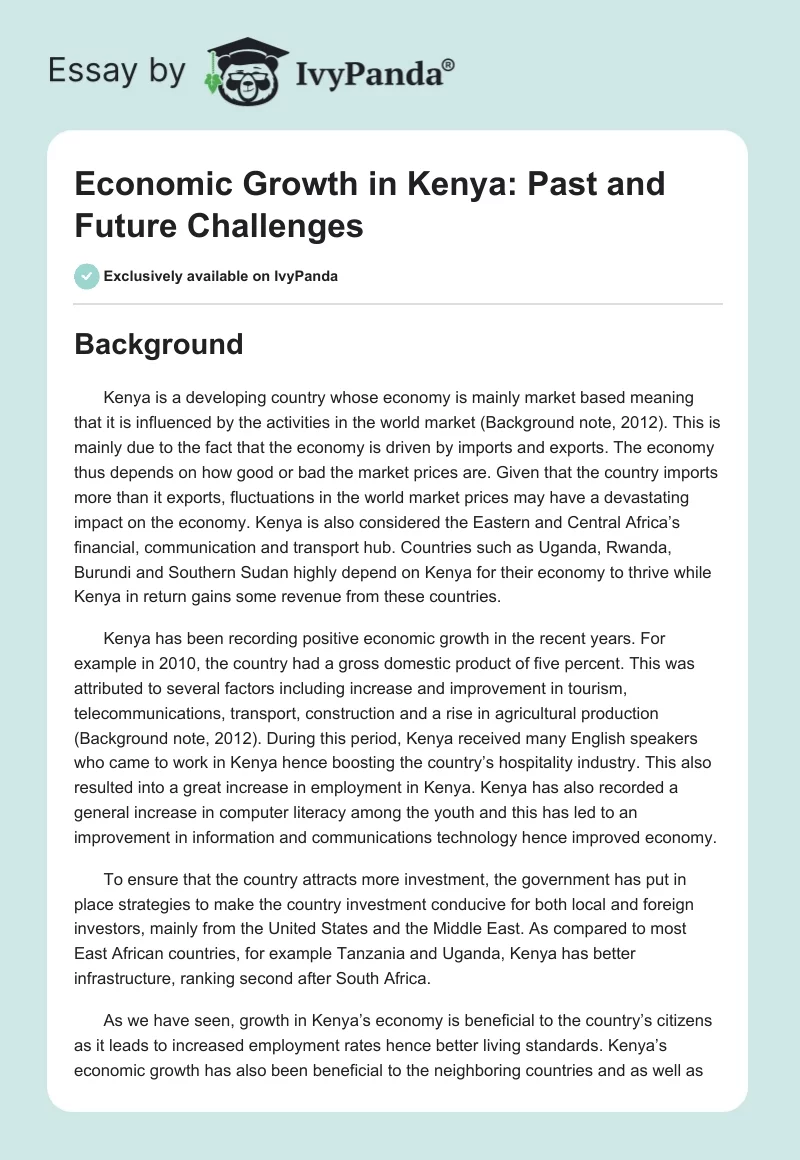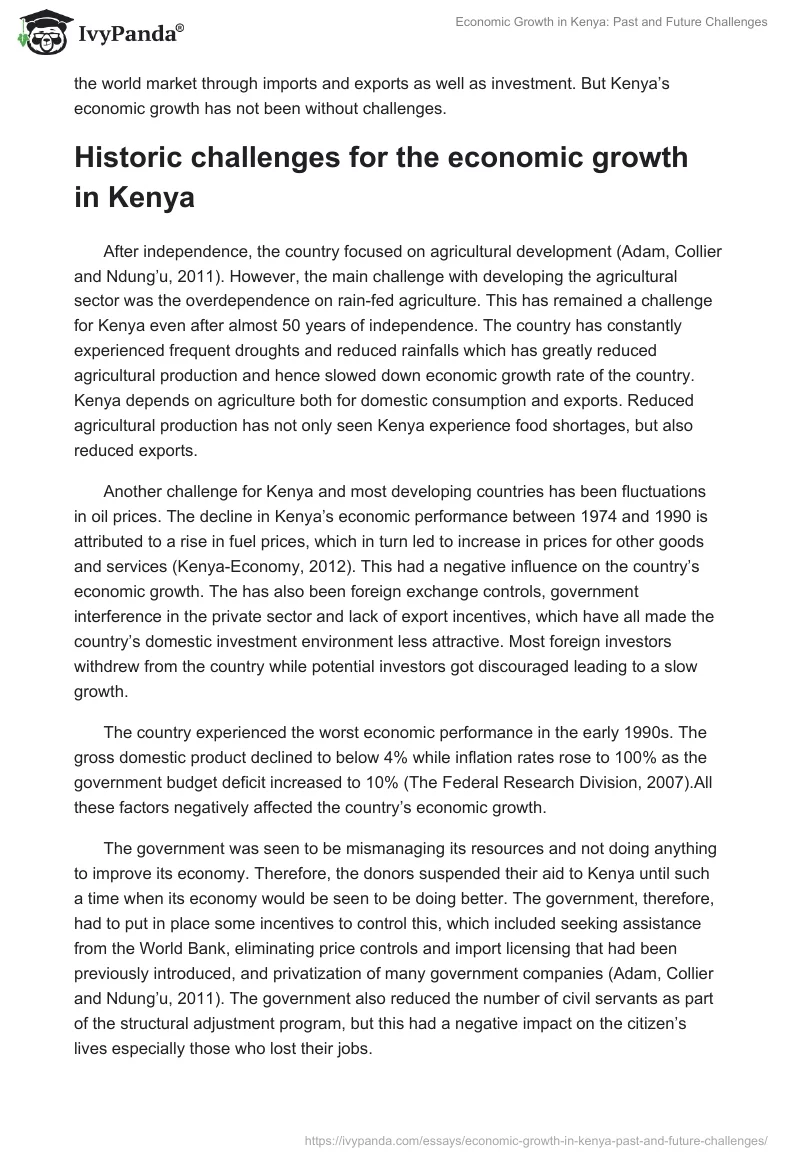Background
Kenya is a developing country whose economy is mainly market based meaning that it is influenced by the activities in the world market (Background note, 2012). This is mainly due to the fact that the economy is driven by imports and exports. The economy thus depends on how good or bad the market prices are. Given that the country imports more than it exports, fluctuations in the world market prices may have a devastating impact on the economy. Kenya is also considered the Eastern and Central Africa’s financial, communication and transport hub. Countries such as Uganda, Rwanda, Burundi and Southern Sudan highly depend on Kenya for their economy to thrive while Kenya in return gains some revenue from these countries.
Kenya has been recording positive economic growth in the recent years. For example in 2010, the country had a gross domestic product of five percent. This was attributed to several factors including increase and improvement in tourism, telecommunications, transport, construction and a rise in agricultural production (Background note, 2012). During this period, Kenya received many English speakers who came to work in Kenya hence boosting the country’s hospitality industry. This also resulted into a great increase in employment in Kenya. Kenya has also recorded a general increase in computer literacy among the youth and this has led to an improvement in information and communications technology hence improved economy.
To ensure that the country attracts more investment, the government has put in place strategies to make the country investment conducive for both local and foreign investors, mainly from the United States and the Middle East. As compared to most East African countries, for example Tanzania and Uganda, Kenya has better infrastructure, ranking second after South Africa.
As we have seen, growth in Kenya’s economy is beneficial to the country’s citizens as it leads to increased employment rates hence better living standards. Kenya’s economic growth has also been beneficial to the neighboring countries and as well as the world market through imports and exports as well as investment. But Kenya’s economic growth has not been without challenges.
Historic challenges for the economic growth in Kenya
After independence, the country focused on agricultural development (Adam, Collier and Ndung’u, 2011). However, the main challenge with developing the agricultural sector was the overdependence on rain-fed agriculture. This has remained a challenge for Kenya even after almost 50 years of independence. The country has constantly experienced frequent droughts and reduced rainfalls which has greatly reduced agricultural production and hence slowed down economic growth rate of the country. Kenya depends on agriculture both for domestic consumption and exports. Reduced agricultural production has not only seen Kenya experience food shortages, but also reduced exports.
Another challenge for Kenya and most developing countries has been fluctuations in oil prices. The decline in Kenya’s economic performance between 1974 and 1990 is attributed to a rise in fuel prices, which in turn led to increase in prices for other goods and services (Kenya-Economy, 2012). This had a negative influence on the country’s economic growth. The has also been foreign exchange controls, government interference in the private sector and lack of export incentives, which have all made the country’s domestic investment environment less attractive. Most foreign investors withdrew from the country while potential investors got discouraged leading to a slow growth.
The country experienced the worst economic performance in the early 1990s. The gross domestic product declined to below 4% while inflation rates rose to 100% as the government budget deficit increased to 10% (The Federal Research Division, 2007). All these factors negatively affected the country’s economic growth.
The government was seen to be mismanaging its resources and not doing anything to improve its economy. Therefore, the donors suspended their aid to Kenya until such a time when its economy would be seen to be doing better. The government, therefore, had to put in place some incentives to control this, which included seeking assistance from the World Bank, eliminating price controls and import licensing that had been previously introduced, and privatization of many government companies (Adam, Collier and Ndung’u, 2011). The government also reduced the number of civil servants as part of the structural adjustment program, but this had a negative impact on the citizen’s lives especially those who lost their jobs.
The gross domestic product, however, picked up as from 1994, but stagnated again in 1997 due to poor weather conditions that affected many economic sectors including agricultural and the tourism (The Federal Research Division, 2007). The situation was further complicated by the general elections in the same year.
The government also failed to meet some requirements set by IMF on government reforms and this has led to the recent suspending of any loan to the country for three years (Kenya- Economy, 2012). Just like IMF, the World Bank has also placed on hold 90 million dollars the country had borrowed for infrastructural improvement.
The economy is and has been dependant on rain-fed agriculture and tourism that is usually greatly affected by cycle booms. Few agricultural products are produced in the country and are highly vulnerable to world fluctuation of prices. The population growth has outstrips economic growth and the country has not been able to recover from this.
Corruption in the country since independence has led to reduced economic growth since this factor scares away investors. There is also the HIV/AIDS pandemic that has been on the rise since the 1980s. This has reduced man power over the years and hence slowed down the economic growth of the country (The Federal Research Division, 2007).
Opinions about how this challenge may change in the future based on the past events
In my opinion, this challenge will change positively in the future. This is due to the following reasons. First, the country highly depends on agriculture as the main economic activity. Since the rains have proven to be very unreliable, the country has put in place irrigation schemes and green houses, which have led to an increase in agricultural production and hence will lead to an improved economy in the future. Second, the country also depends highly on tourism, which has proven not to be unreliable due to fluctuation booms. The government will thus use this knowledge to put in place other sources of revenue to substitute for tourism like improved information and communications technology.
Third, the 1997 general elections saw the country economic growth reduce because there were reduced economic activities. This was a lesson for the government to keep politics out of the country’s economy in future. Fourth, the government failed to put in place government reforms as stated by IMF in 1997. Hence IMF and the World Bank suspended their help. This contributed negatively to the country’s economy and the government now knows better. Therefore, the government will not play around with potential aides in the future. Last, but not least, the HIV/AIDS epidemic has been taken care of. The patients are adequately supplied with ARVs, which help them to be more productive in the country’s economy. There is also an initiative to replace manpower with machines so that a reduction in man power will not affect the country’s economic growth.
References
Adam, C., Collier, P. & Ndung’u, N. (2011). Kenya: policies for prosperity. Oxford: Oxford University Press.
Background note: Kenya (2012). U.S. Department of State. Web.
Federal Research Division (2007). Country profile: Kenya. New York: Library of Congress-Federal Research Division.
Kenya- Economy (2012). Encyclopedia of the Nations. Web.


